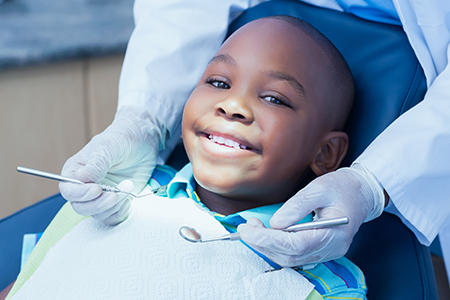
At the office of Callahan Family Dentistry, the health and growth of your child’s smile is treated with thoughtful, evidence-based care. Our goal is to help children build strong oral habits, avoid preventable problems, and gain the confidence that comes with a healthy smile.

Good oral health begins long before permanent teeth arrive. Early, consistent routines—age-appropriate brushing, supervised flossing, and regular dental visits—give children the tools they need to care for their mouths independently as they grow. Starting early also helps normalize dental visits so they become a comfortable part of a child’s life.
Preventive care is about more than avoiding cavities. We look for changes in growth, track how teeth come in, and advise families on nutrition and habits that support strong teeth and gums. Preventive visits are opportunities to teach and to intervene early when issues appear, which reduces the need for more invasive care later on.
Parents are essential partners in this process. Our team provides practical guidance for establishing routines at home, from choosing the right toothbrush to making brushing time engaging for young children. When the home routine and professional care work together, children are far more likely to enjoy lasting oral health.
Children respond best to dentistry that combines clinical skill with patience and creativity. Our office is designed to reduce anxiety and make visits predictable and pleasant. Staff members are trained in communication techniques that help children understand what’s happening and feel in control, which makes exams and cleanings smoother for everyone.
We tailor our approach to each child’s age and temperament. For some kids, gentle reassurance and clear explanations are enough; others benefit from distraction techniques, behavioral guidance, or a stepwise introduction to treatment. Our aim is always to deliver compassionate care while maintaining high clinical standards.
When special considerations are needed—whether due to developmental concerns, medical complexity, or strong dental anxiety—we discuss appropriate options with parents and guardians. The focus remains on safety, comfort, and delivering effective treatment in a way that preserves a child’s trust in dental care.

Regular checkups create a reliable rhythm of care. During a typical visit we review your child’s medical and dental history, perform a visual assessment of teeth and soft tissues, and evaluate jaw growth and bite development. Cleanings remove plaque and buildup that brushing alone can miss, and provide a fresh start until the next appointment.
We use modern digital imaging only when it’s necessary to get a clear view beneath the surface. These low-dose radiographs help detect decay early, assess developing teeth, and guide treatment decisions. Every diagnostic step is taken with attention to safety and the child’s long-term well-being.
Periodically, we will discuss preventive measures such as fluoride applications and dental sealants. These simple, painless treatments strengthen enamel and protect vulnerable tooth surfaces as permanent molars and premolars come in.
Tooth decay is a process that develops over time, driven by bacteria, dietary sugars, and inadequate removal of plaque. Because decay can progress quickly in primary teeth, early detection and treatment are important to prevent pain, infection, and damage to developing adult teeth.
Prevention combines home care, dietary choices, and in-office interventions. We emphasize consistent brushing with fluoride toothpaste, limiting sugary snacks and drinks, and stabilizing risky habits like frequent grazing. Professionally applied fluoride and sealants offer extra protection on newly erupted back teeth, where grooves are prone to trapping food and bacteria.
When decay does occur, we prioritize conservative approaches that restore function and comfort while preserving healthy tooth structure. Treatment is delivered with a focus on minimizing stress for the child and educating the family about preventing recurrence.
Begin dental care early — wipe gums after feeding and introduce a soft brush when the first teeth appear.
Brush twice daily with an age-appropriate amount of fluoride toothpaste and supervise brushing until the child can do it effectively.
Avoid letting infants sleep with bottles containing milk, formula, or juice to reduce nighttime exposure to sugars.
Bring your child for routine checkups as recommended so we can monitor growth and address small issues before they become larger problems.
Lead by example—children mimic adult behavior, so practicing good oral hygiene together reinforces lifelong habits.
Choose tooth-friendly snacks, encourage water instead of sugary beverages, and limit frequency of treats between meals.
Work with your dentist if thumb-sucking or pacifier use continues past early childhood; timely guidance can prevent bite changes.
Make sure your child wears a properly fitted mouthguard for contact or high-impact sports to protect teeth and jaws.

Even before a child’s first birthday, much of the groundwork for dental health is already in place. Primary teeth begin developing in utero and typically start to appear around six months of age. Early visits help parents learn how to clean tiny teeth safely and establish a positive relationship with the dentist.
The American dental organizations recommend that a child see a dental professional around the time of the first tooth or the first birthday. These early checkups allow us to offer guidance on teething comfort measures, safe feeding practices, and the transition to brushing with fluoride toothpaste when appropriate.
Primary teeth serve important roles in chewing, speech development, and holding space for permanent teeth. Protecting those teeth supports a child’s overall health and makes the transition to adult dentition smoother and more predictable.
As children grow and become more active, their risk of dental injury increases. Well-fitted mouthguards are the simplest, most effective way to reduce the chance of fractured, knocked-out, or injured teeth during sports and recreation. We advise on the right type of protection for your child’s activities.
Orthodontic concerns are another area we routinely monitor. Early evaluation of jaw growth and bite alignment allows us to identify patterns that may benefit from referral or early intervention. Addressing growth-related issues at the right time can simplify future treatment and improve long-term outcomes.
When accidents do happen—whether a chipped tooth, a tooth that’s been displaced, or a sudden toothache—timely assessment is critical. Our team is prepared to evaluate injuries and start appropriate care promptly to preserve oral health and comfort.
At Callahan Family Dentistry, our approach to pediatric care combines prevention, education, and compassionate clinical treatment to support healthy smiles through childhood and beyond. If you would like more information about our pediatric services or want to discuss an individual care plan for your child, please contact us for details.
A pedodontist is a dentist who has received advanced specialty training in meeting the dental needs of children from infancy to adolescence. Pedodontists, also referred to as "pediatric dentists," study child psychology, behavior management, caring for children with special needs, methods of handling oral/facial trauma, and various techniques for providing anesthesia and sedation. Pedodontists also understand the complexities of facial growth and development and have the clinical skills required to meet the dental needs of all children at every stage of development. Most of all, pedodontists are passionate about what they do and enjoy working with children. They strive to make every dental experience a positive one as they help children establish a strong foundation for good oral health.
Even before your child is born, their first set of teeth is already forming. In fact, by one year of age, some of your baby's front teeth will have already come into place. While the arrival of your baby's first teeth is only one of many developmental milestones, it represents an excellent time to begin a program of oral care. According to recommendations from the American Dental Association, babies should see the dentist around the time of their first birthdays.
Your baby's first teeth typically begin to appear in the 6 to 12-month range. While this is an extraordinary milestone, you need to be aware that your baby may find the experience a little bit uncomfortable. Teething can make babies feel irritable. They may be fussy, have trouble sleeping, not want to eat, and drool quite a bit.
Although you are powerless to speed up the process of teething, there are a few things that you can do to soothe your baby as the new teeth are erupting into place. Common approaches to helping your baby feel more comfortable while getting new teeth, include teething rings or a cold spoon or moist gauze rubbed over their gums.
Even for these few new teeth, it's absolutely essential to establish an effective regimen of oral care. For information on when your baby's first set of teeth will erupt into place, consult this timeline from the American Dental Association: Eruption Charts
Some children persist in sucking their thumbs or fingers beyond their preschool years. For these children, the activity continues to be a source of comfort, relaxation, and security. It may even help them fall asleep at night. However, it's essential to be aware that in the long-term, a finger sucking habit is not healthy.
If your child's thumb or finger sucking habit is still present when the permanent teeth begin to come in, your child is at a higher risk of developing a bad bite. By the age of five or six years, you need to constructively and gently help your child stop the habit.
It's also a good idea to have a comprehensive evaluation at this time. Your pedodontist can assess if there are any habit related alterations to the alignment of your child's teeth or jaws, or if it is affecting their speech or swallowing patterns. They can also discuss habit control strategies with you, as well as follow your child's bite and facial development as they grow. If interceptive appliances or corrective orthodontic care are recommended, the timetable and best options in care will be explained in complete detail.
Our goal is to help every patient experience the benefits of good oral health and a beautiful smile. We value the trust you have placed in our office and strive to provide solutions that meet your dental needs and expectations of care.
